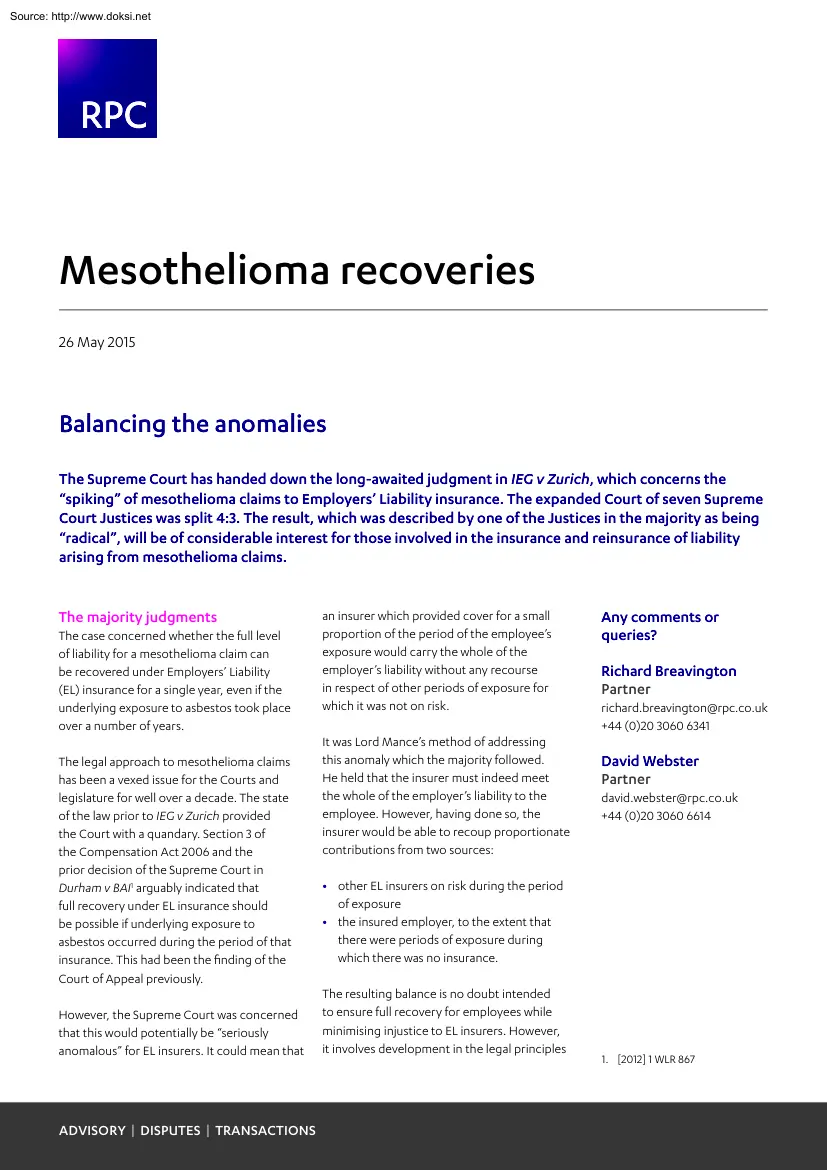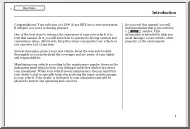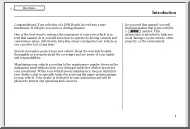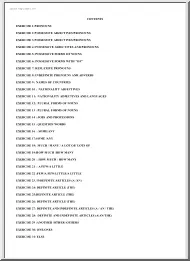Comments
No comments yet. You can be the first!
Content extract
Source: http://www.doksinet Mesothelioma recoveries 26 May 2015 Balancing the anomalies The Supreme Court has handed down the long-awaited judgment in IEG v Zurich, which concerns the “spiking” of mesothelioma claims to Employers’ Liability insurance. The expanded Court of seven Supreme Court Justices was split 4:3. The result, which was described by one of the Justices in the majority as being “radical”, will be of considerable interest for those involved in the insurance and reinsurance of liability arising from mesothelioma claims. The majority judgments The case concerned whether the full level of liability for a mesothelioma claim can be recovered under Employers’ Liability (EL) insurance for a single year, even if the underlying exposure to asbestos took place over a number of years. The legal approach to mesothelioma claims has been a vexed issue for the Courts and legislature for well over a decade. The state of the law prior to IEG v Zurich provided the Court
with a quandary. Section 3 of the Compensation Act 2006 and the prior decision of the Supreme Court in Durham v BAI1 arguably indicated that full recovery under EL insurance should be possible if underlying exposure to asbestos occurred during the period of that insurance. This had been the finding of the Court of Appeal previously. However, the Supreme Court was concerned that this would potentially be “seriously anomalous” for EL insurers. It could mean that ADVISORY | DISPUTES | TRANSACTIONS an insurer which provided cover for a small proportion of the period of the employee’s exposure would carry the whole of the employer’s liability without any recourse in respect of other periods of exposure for which it was not on risk. It was Lord Mance’s method of addressing this anomaly which the majority followed. He held that the insurer must indeed meet the whole of the employer’s liability to the employee. However, having done so, the insurer would be able to recoup
proportionate contributions from two sources: Any comments or queries? Richard Breavington Partner richard.breavington@rpccouk +44 (0)20 3060 6341 David Webster Partner david.webster@rpccouk +44 (0)20 3060 6614 •• other EL insurers on risk during the period of exposure •• the insured employer, to the extent that there were periods of exposure during which there was no insurance. The resulting balance is no doubt intended to ensure full recovery for employees while minimising injustice to EL insurers. However, it involves development in the legal principles 1. [2012] 1 WLR 867 Source: http://www.doksinet Mesothelioma recoveries 26 May 2015 relating to contribution, double insurance and self-insurance which could leave room for dispute in future. A quirk of the case is that in fact the reasoning described above was all obiter. The case concerned Guernsey law, to which the Compensation Act 2006 does not apply. The Court unanimously held that in light of this, the previous
decision in Barker v Corus2 meant that liability should be apportioned across the period of exposure. Nevertheless, as regards the rest of the UK to which the Compensation Act 2006 does apply, the obiter guidance of a strong, if divided, Supreme Court will be authoritative. Implications for EL insurers The decision in effect shifts the burden of making proportionate recoveries onto the EL insurer from which the loss is initially claimed. That EL insurer could have the benefit of considerable scope for making such recoveries from other insurers and the insured. However, based on Lord Mance’s guidance, it would take the risk of an inability to recover from an insolvent insured in respect of uninsured periods of exposure and the practical burden of recoveries generally. There might also be difficulty in recovering in relation to a period of exposure in respect of which another EL insurer is insolvent. Implications for reinsurers One of the most interesting aspects of the judgment is
its consequences for reinsurance recoveries in respect of mesothelioma claims. Reinsurance for a single period of exposure should respond to the full loss, but reinsurers would then be able to recoup proportionately from other reinsurers and the reinsured. The precise scope of that ability to recoup is subject to potential uncertainty. For example: •• Would the reinsured or the reinsurer bear the burden of pursuing recoveries from reinsureds who are liable to contribute to the loss? •• Who takes the risk of insolvent reinsurers or reinsureds from whom contribution would be due? •• To what extent will a reinsured be taken to be self-insured? •• How do the principles apply to subscription risks? These issues could present a challenge to the reinsurance market, with potentially significant sums at stake. Whatever happens, it remains to be seen whether there could yet be further developments in the UK jurisprudence around this interesting and challenging area. 2. [2006]
UKHL 20 14724 Tower Bridge House St Katharine’s Way London E1W 1AA T +44 (0)20 3060 6000 Temple Circus Temple Way Bristol BS1 6LW T +44 (0)20 3060 6000 11/F Three Exchange Square 8 Connaught Place Central Hong Kong T +852 2216 7000 8 Marina View #34-02A Asia Square Tower 1 Singapore 018960 T +65 6818 5695 2
with a quandary. Section 3 of the Compensation Act 2006 and the prior decision of the Supreme Court in Durham v BAI1 arguably indicated that full recovery under EL insurance should be possible if underlying exposure to asbestos occurred during the period of that insurance. This had been the finding of the Court of Appeal previously. However, the Supreme Court was concerned that this would potentially be “seriously anomalous” for EL insurers. It could mean that ADVISORY | DISPUTES | TRANSACTIONS an insurer which provided cover for a small proportion of the period of the employee’s exposure would carry the whole of the employer’s liability without any recourse in respect of other periods of exposure for which it was not on risk. It was Lord Mance’s method of addressing this anomaly which the majority followed. He held that the insurer must indeed meet the whole of the employer’s liability to the employee. However, having done so, the insurer would be able to recoup
proportionate contributions from two sources: Any comments or queries? Richard Breavington Partner richard.breavington@rpccouk +44 (0)20 3060 6341 David Webster Partner david.webster@rpccouk +44 (0)20 3060 6614 •• other EL insurers on risk during the period of exposure •• the insured employer, to the extent that there were periods of exposure during which there was no insurance. The resulting balance is no doubt intended to ensure full recovery for employees while minimising injustice to EL insurers. However, it involves development in the legal principles 1. [2012] 1 WLR 867 Source: http://www.doksinet Mesothelioma recoveries 26 May 2015 relating to contribution, double insurance and self-insurance which could leave room for dispute in future. A quirk of the case is that in fact the reasoning described above was all obiter. The case concerned Guernsey law, to which the Compensation Act 2006 does not apply. The Court unanimously held that in light of this, the previous
decision in Barker v Corus2 meant that liability should be apportioned across the period of exposure. Nevertheless, as regards the rest of the UK to which the Compensation Act 2006 does apply, the obiter guidance of a strong, if divided, Supreme Court will be authoritative. Implications for EL insurers The decision in effect shifts the burden of making proportionate recoveries onto the EL insurer from which the loss is initially claimed. That EL insurer could have the benefit of considerable scope for making such recoveries from other insurers and the insured. However, based on Lord Mance’s guidance, it would take the risk of an inability to recover from an insolvent insured in respect of uninsured periods of exposure and the practical burden of recoveries generally. There might also be difficulty in recovering in relation to a period of exposure in respect of which another EL insurer is insolvent. Implications for reinsurers One of the most interesting aspects of the judgment is
its consequences for reinsurance recoveries in respect of mesothelioma claims. Reinsurance for a single period of exposure should respond to the full loss, but reinsurers would then be able to recoup proportionately from other reinsurers and the reinsured. The precise scope of that ability to recoup is subject to potential uncertainty. For example: •• Would the reinsured or the reinsurer bear the burden of pursuing recoveries from reinsureds who are liable to contribute to the loss? •• Who takes the risk of insolvent reinsurers or reinsureds from whom contribution would be due? •• To what extent will a reinsured be taken to be self-insured? •• How do the principles apply to subscription risks? These issues could present a challenge to the reinsurance market, with potentially significant sums at stake. Whatever happens, it remains to be seen whether there could yet be further developments in the UK jurisprudence around this interesting and challenging area. 2. [2006]
UKHL 20 14724 Tower Bridge House St Katharine’s Way London E1W 1AA T +44 (0)20 3060 6000 Temple Circus Temple Way Bristol BS1 6LW T +44 (0)20 3060 6000 11/F Three Exchange Square 8 Connaught Place Central Hong Kong T +852 2216 7000 8 Marina View #34-02A Asia Square Tower 1 Singapore 018960 T +65 6818 5695 2





